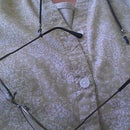Introduction: Figuring Measurements of a 5-pointed Symmetrical Lighted Star
Have a frame and want to know how many feet of light strings you'll want to go around the perimeter or across the points?
Want to form a star of a particular height? Take a look at the photos.
Note, this is for a Symmetrical Star -- all 5 points have the same angle, and all 10 outer sides along the perimeter are equal.
QUICK FACTS:
- The angle in any point (or tip) of the star is 36 degrees.
- If you bisect the angle in any point (split it in half), each angle is 18 degrees.
Because this angle is always the same, given only the measurement along one of the outer sides of the star, as long as it is a Symmetrical Star, you can calculate the other dimensions. Or given one of the other dimensions, you can calculate the side.
The parts of this Symmetrical Star are always in the same ratios or proportions to each other. So they're easy to calculate.
Step 1: Sides, Base, Inner Chord Measurements
If you know the measurement along one side of a star point -- for instance, the distance between A and B in the drawing, then the following calculations are possible.
( Note that for a "Side," any two points along the perimeter would do, as long as they're neighbors. )
QUICK RESULTS:
- The "Base" (see drawing) will be always be 0.309 times the measurement of any one of the sides of a StarPoint. Another way of saying this is that the Base is 30.9% of the size of any Side -- when it's a Symmetrical Star. If the Side of the star were 100 miles long, the Base would be 30.9 miles long.
- Because the "Inner Chord" (see drawing) is just two Bases added together, the length of the Inner Cord will be (2 x 0.309 ) = ( 0.618) times the measurement of any one of the Sides of a star's point. (Remember the sides are all the same measurements for any particular Symmetrical Star.)
Step 2: Measuring Around the Perimeter (10 Sides) or Across From Point to Opposite Point in 5-Segments
If you know the measurement along one side of a star point, then:
QUICK RESULTS:
- The Perimeter will be the sum of ten of the sides of a star point.
(Obviously. Just go around the star on the outside, starting at any point and ending up back there.)
- The"Length Across" from any one of the 5 points to the point opposite it will be 2.618 times the measurement of the Side of a Star Point.
(For instance, in the drawing, the distance from A to E will be 2.618 times the measurement from A to B. This is because you're adding together AB, an Inner Chord, and BE. AB and BE are the same length because it's a Symmetrical Star, so that adds up to 2 Sides, and the Inner Chord is 0.618 of any Side. The sum across from A to E is 2.618 x AB or 2.618 times a Side. )
- The total measurement for forming the star by going across from point to opposite point in succession will be 5 times the length between two opposite points. Or just multiply your known measurement along one side of a StarPoint by (5 x 2.618) = 13.09.
We're talking about starting at the bottom left point C, going across to the opposite point I, then
down to E, back across to A, horizontally across to G, then down and across -- until you get back to your starting point C.
Step 3: From Knowing a Side to Height -- and Back Again
So if you know the measurement of a Side, then you can add up the measurement from one point across to it's opposite point. (See previous steps.)
From that number you can calculate the actual height of the star. (The red line in the drawings.)
QUICK RESULTS:
- The height of the star will be 0.9511 times that length across between opposite points.
Working backwards, if you know the height of the star, then:
QUICK RESULTS:
- Divide the height by 0.9511 to get the length across between two opposite points.
- Divide the height by 0.9511 and then divide that result by 2.618 to get the measurement along one Side of one StarPoint.
Step 4: Example 30" Star
If I want a star that is 2.5 feet (30 inches) high, then...
-----------------------------
How much wire do I need to go around the perimeter? I need to figure out the measurement of one Side of a "StarPoint" then I know I'll need TEN of those to complete the perimeter.
Height = 30"
One Side of a StarPoint = Height / (.9511)x(2.618)
For my 30" high star, one side will be 30" divided by those 2 numbers... or 12.0483 inches, just barely over 12 inches.
Ten times that number should be about ten feet for the perimeter, of course, almost a half inch over. Plus whatever overlap or losses I'd have in real life, of course.
----------------------------
If I choose to traverse the star by going from one point to another across the star to opposite points, how much wire would I need to complete the star? I need to figure out the length from one point to the opposite point, then multiply that by FIVE.
Height = 30"
Length Across to Opposite Point = Height / (.9511)
For my 30" high star, 30"/.9511 is 28.533 inches, and five of those segments will complete a star. I need 142.665 inches or 11 feet plus 10.665 inches. (Or 11 feet and a bit under10 and11/16" -- how accurate do you need to be for a 30" star?)
----------------------------
If I only want to know the "Inner Chord" for a 30" high star, that's two Base measurements.
Height = 30"
One Side of a StarPoint = Height divided by [ (.9511)x(2.618) ] = 12.0483inches
Inner Chord = Base + Base = 2 x Base = 2 x (0.309) x One Side of a StarPoint
= 2 x 0.309 x 12.0483inches = 7.4458 inches
So the inner chord is a bit over 7 and 7/16 inches.
Step 5: A Real Life Star
So check out my real life star.
https://www.instructables.com/id/Intro-DIY-Lighted-Star-From-5-Coat-Hangers-a-Rope-
I started with the sides of the star, about 8 5/8" long. (That was determined by the size of my coat hangers that I built the frame with before laying rope light over it.)
How tall did it turn out to be? How much rope light did I use going across from one point to the other? (You can see we didn't just go around the perimeter, which gave it more strength.)
Answers:
- I guesstimated about a little under 2 feet tall. What does the Math say?
Height = (One side of the star point) x (0.9511) x (2.618)
= 8.625" x 0.9511 x 2.618 = 21.476" tall
When we pull down the Christmas outside lights in January, I guess I'll find out how close I was.
It's just the right size for our outside lighted "tree."
- I had an 18 ft rope light. It went across all the legs and then I knew I'd have some left over, plus some of it was the plug end without lights. What does the math say?
Length across to opposite point = 2.618 x 8.625" side
= 22.58 inches
And five times that to complete one pass around the star should have been 112.9 inches.
Again, it's 15 ft up in the air for now. Have to wait to see if the math works. But I knew from doing the math that I had enough rope light to go around once, but not twice.
If you want to know how to build this lighted star, I'm publishing the Instructable. I'll include a link when it's up. Making my own star is why I had to jot down the geometry of the star.
Hope it's useful to someone else.













